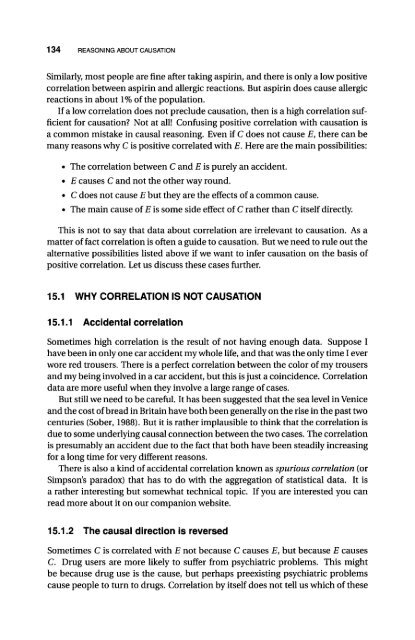An Introduction to Critical Thinking and Creativity - always yours
An Introduction to Critical Thinking and Creativity - always yours
An Introduction to Critical Thinking and Creativity - always yours
Create successful ePaper yourself
Turn your PDF publications into a flip-book with our unique Google optimized e-Paper software.
134 REASONING ABOUT CAUSATION<br />
Similarly, most people are fine after taking aspirin, <strong>and</strong> there is only a low positive<br />
correlation between aspirin <strong>and</strong> allergic reactions. But aspirin does cause allergic<br />
reactions in about 1% of the population.<br />
If a low correlation does not preclude causation, then is a high correlation sufficient<br />
for causation? Not at all! Confusing positive correlation with causation is<br />
a common mistake in causal reasoning. Even if C does not cause E, there can be<br />
many reasons why C is positive correlated with E. Here are the main possibilities:<br />
• The correlation between C <strong>and</strong> E is purely an accident.<br />
• E causes C <strong>and</strong> not the other way round.<br />
• C does not cause E but they are the effects of a common cause.<br />
• The main cause of E is some side effect of C rather than C itself directly.<br />
This is not <strong>to</strong> say that data about correlation are irrelevant <strong>to</strong> causation. As a<br />
matter of fact correlation is often a guide <strong>to</strong> causation. But we need <strong>to</strong> rule out the<br />
alternative possibilities listed above if we want <strong>to</strong> infer causation on the basis of<br />
positive correlation. Let us discuss these cases further.<br />
15.1 WHY CORRELATION IS NOT CAUSATION<br />
15.1.1 Accidental correlation<br />
Sometimes high correlation is the result of not having enough data. Suppose I<br />
have been in only one car accident my whole life, <strong>and</strong> that was the only time I ever<br />
wore red trousers. There is a perfect correlation between the color of my trousers<br />
<strong>and</strong> my being involved in a car accident, but this is just a coincidence. Correlation<br />
data are more useful when they involve a large range of cases.<br />
But still we need <strong>to</strong> be careful. It has been suggested that the sea level in Venice<br />
<strong>and</strong> the cost of bread in Britain have both been generally on the rise in the past two<br />
centuries (Sober, 1988). But it is rather implausible <strong>to</strong> think that the correlation is<br />
due <strong>to</strong> some underlying causal connection between the two cases. The correlation<br />
is presumably an accident due <strong>to</strong> the fact that both have been steadily increasing<br />
for a long time for very different reasons.<br />
There is also a kind of accidental correlation known as spurious correlation (or<br />
Simpson's paradox) that has <strong>to</strong> do with the aggregation of statistical data. It is<br />
a rather interesting but somewhat technical <strong>to</strong>pic. If you are interested you can<br />
read more about it on our companion website.<br />
15.1.2 The causal direction is reversed<br />
Sometimes C is correlated with E not because C causes E, but because E causes<br />
C. Drug users are more likely <strong>to</strong> suffer from psychiatric problems. This might<br />
be because drug use is the cause, but perhaps preexisting psychiatric problems<br />
cause people <strong>to</strong> turn <strong>to</strong> drugs. Correlation by itself does not tell us which of these
















